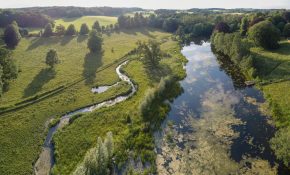Fish migration routes restored on the River Tiffey
Fish migration routes restored on the River Tiffey
Britain’s rivers have been heavily modified with the installation of structures, such as road bridges, weirs and mills, in the river channel. These create barriers to fish migration, and impact the hydrogeomorphology and natural flow patterns of rivers. In many cases, this has changed the ecological communities found upstream of the barriers due to genetic isolation (resulting in localised extinctions) and unnatural species composition.
Where possible, the Environment Agency and Norfolk Rivers Trust are working together to remove or adapt these barriers.
In Wymondham, a redundant weir from a brush factory was noted as a barrier to fish migration following a fish survey. This was subsequently removed in 2018 (see full story here), allowing fish to swim upstream and opening up more bank edge habitat for water voles.
The survey also identified that the bridge sill on Becketswell bridge presented a considerable obstacle to fish movement during low flows; the depth of water flowing over the bridge could not accommodate many fish, and the 30cm jump was too high for fish species such as bullhead.
In May 2021, after 3 years of consultation and design (which included modelling flood risk, assessing bridge structure, and creating a safe space for people to paddle in), the fish pass at Becketswell bridge was completed.

Before works

After works
A debris boom has also been installed upstream of Becketswell bridge to prevent debris from blocking the notches – which have been specially designed for the fish to swim through.
Ursula Juta, Catchment and Education Manager at Norfolk Rivers Trust, said: “Working in the Tiffey catchment has been lovely. The residents have shown so much interest and support, and clearly care a lot about their river.”
She added: “Working on a project which not only improves things ecologically, but also for local people is very rewarding. If people are aware of what’s in their river, they are less likely to drop litter and pollute it. The Tiffey is full of fish and I was able to tell people about it, and I hope they go on to tell more people. Sharing knowledge and empowering local communities is the only way we can bring about change.”
James Anderson, from Aquamaintain who constructed the fish pass, said: “The installation process was a nice challenge for us. Using natural materials like the oak sleepers for the fish pass makes it fit right in to the landscape. It is subtle and inconspicuous. We’ve also installed eel tiles which run along the corrugated sheet piling to give the critically-endangered species an extra helping hand.”
Amy Prendergast, catchment co-ordinator at the Environment Agency in East Anglia, said: “We are so proud to see the completion of this project, which has brought so many benefits to the local ecology. Removing the weir has helped to restore the river to a more natural habitat and also reduced the flood risk to properties near Damgate Bridge. The new fish pass further enhances those improvements, as now all species of fish can continue their journeys upstream.”
She added: “We are grateful to Norfolk Rivers Trust for all their hard work in helping make this project a success. We would also like to thank the funding partners Broadland Catchment Partnership, as well as the town council and residents for being so encouraging.”
Further monitoring will continue at the site, and Norfolk Rivers Trust and the Environment Agency are committed to delivering more of these fish pass projects around Norfolk over the next few years.












